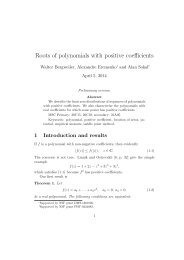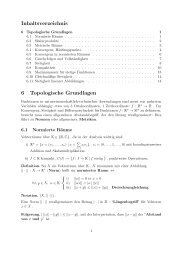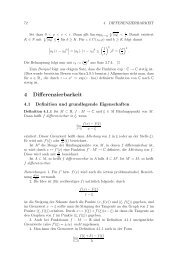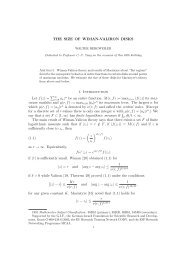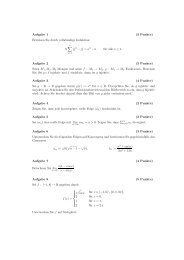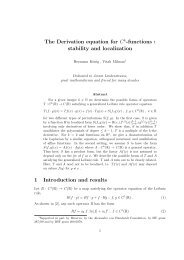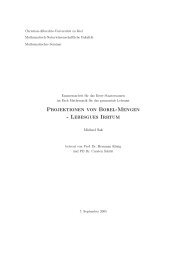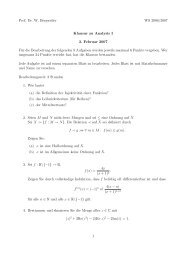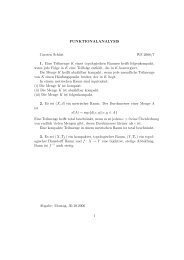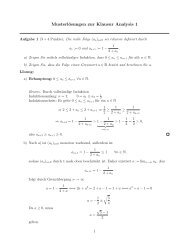Partielle Differentialgleichungen in der Finanzmathematik Vorlesung ...
Partielle Differentialgleichungen in der Finanzmathematik Vorlesung ...
Partielle Differentialgleichungen in der Finanzmathematik Vorlesung ...
Sie wollen auch ein ePaper? Erhöhen Sie die Reichweite Ihrer Titel.
YUMPU macht aus Druck-PDFs automatisch weboptimierte ePaper, die Google liebt.
4 PARABOLISCHE GLEICHUNGEN 2. ORDNUNG MIT KONSTANTEN KOEFFIZIENTEN32Sei nun δ ∈ R >0 . Wähle t 0 ∈ R >0 so, daß δ 0 := ‖a 1/2 ‖ −1 δ − t 0 ‖a −1/2 b‖ > 0 ist. Dann gilt füralle t ∈ [0, t 0 ] und x ∈ R n :‖x‖ ≥ δ ⇒ ‖a −1/2 (x + tb)‖ ≥ ∣ ‖a −1/2 x‖ − t‖a −1/2 b‖ ∣ = ‖a −1/2 x‖ − t‖a −1/2 b‖≥ ‖a 1/2 ‖ −1 ‖x‖ − t 0 ‖a −1/2 b‖ ≥ ‖a 1/2 ‖ −1 δ − t 0 ‖a −1/2 b‖,also ‖x‖ ≥ δ ⇒ ‖a −1/2 (x + tb)‖ ≥ δ 0 . Damit folgt für t ≤ t 0 :∫∫∫1˜k t (x) dx ≤‖x‖≥δ‖a −1/2 (x+tb)‖≥δ 0det a 1/2 h t(a −1/2 (x + tb)) dx = h t (y) dy t→0 → 0‖y‖≥δ 0Die gleiche Transformation, die die Kerne h t und k t <strong>in</strong>e<strong>in</strong>an<strong>der</strong> überführt, transformiert auchLösungen <strong>der</strong> Wärmeleitungsgleichung <strong>in</strong> Lösungen <strong>der</strong> allgeme<strong>in</strong>en Gleichung. Genauer gilt <strong>der</strong>folgendeSatz 4.13 (Transformationssatz). Seien u, v : I × R n → R und C 1,2 , und für alle t ∈ I undx, y ∈ R n geltev(t, x) = e ct u(t, a −1/2 (x + tb))bzw. u(t, y) = e −ct v(t, a 1/2 y − tb).Dann gilt für alle (t, x) ∈ ]0, T [ ×R n mit y := a −1/2 (x + tb):(∂ t v − P (D)v)(t, x) = e ct (∂ t u − ∆u)(t, y) undv(0, x) = u(0, a −1/2 x).Bemerkung 4.14. E<strong>in</strong>e Umformulierung von Satz 4.13 ist die folgende: Mit <strong>der</strong> Transformationũ(t, x) := e ct u(t, a −1/2 (x + tb)) gilt(∂ t − P (D))ũ = ((∂ ˜ t − ∆)u )Beweis von Satz 4.13. Seien (t, x) ∈ ]0, T [ ×R n und y := a −1/2 (x + tb). Dann gilt zunächst∂ t v(t, x) = cv(t, x) + e ct (∂ t u(t, y) + ∇ y u(t, y) · a −1/2 b).Gemäß (4.1) gilt außerdemP (D)v = Spur(a · ∇ 2 xv) + ∇ x v · b + cv,wobei ∇ x den Gradienten und ∇ 2 x die Hesse-Matrix bezüglich <strong>der</strong> x-Variablen bezeichnet. Es ist∇ x v(t, x) = e ct ∇ y u(t, y) · a −1/2 und ∇ 2 xv(t, x) = e ct a −1/2 · ∇ 2 yu(t, y) · a −1/2 ,alsoSpur(a · ∇ 2 xv)(t, x) = e ct Spur(a · a −1/2 · ∇ 2 yu(t, y) · a −1/2 ) = e ct Spur(a 1/2 · ∇ 2 yu(t, y) · a −1/2 )= e ct Spur(∇ 2 yu(t, y)) = e ct ∆ y u(t, y).



